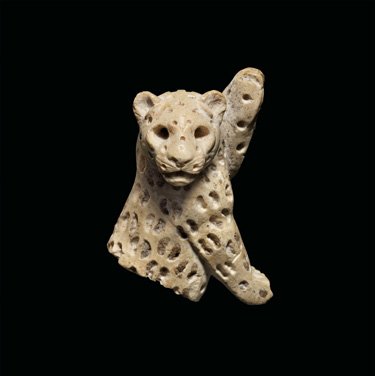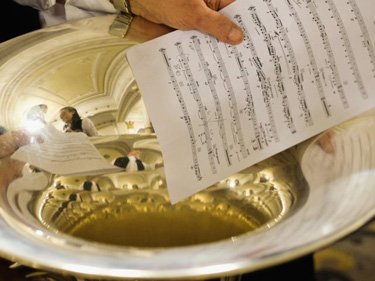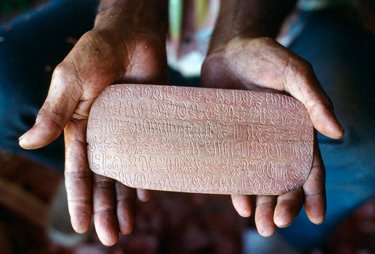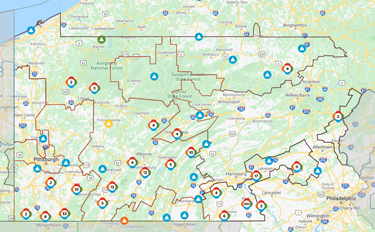Archive for March, 2021
31 Mar 2021


National Park Service Team
Our neighbor in Mississippi, Phillip Kyle Knecht yesterday posted on Facebook:
“For the last week, a team from the National Park Service’s National Center for Preservation Technology and Training has been in Holly Springs, documenting and scanning various extant slave quarters, slave cabins and tenant/sharecropper housing. The team used a really fancy 3D laser scanner, that will create 3D images of the exterior and interior of these structures. Eventually, they will be able to create “virtual reality” tours of these structures.
Thank you to the members of the team, Isabella Jones, Sreya Chakraborty, and Ina Sthapit, for coming to town and performing this invaluable service. Thank you also to Pam Zelman, with Preserve Marshall County and Holly Springs, Inc., who did much of the heavy lifting locally, arranging access to all of these sites. Thank you to the homeowners who graciously opened their doors to the team. I acted as a sort of local historical advisor at a few of their stops. Chelius Carter, with PMCHS, was instrumental in getting the team to town, and allowed the team to stay in the Hugh Craft House.
The team has a few more stops before they leave town on Friday, so if you see them around, welcome them to town! This is really important historical and preservation work.”
Our new home, Cedarhurst, has the old Antebellum kitchen and servants’ quarters in the backyard, remodeled in recent years with little architectural regard, alas! into an auxiliary apartment.
Karen contacted the Park Service team, and they are going to survey the Cedarhurst kitchen next!

30 Mar 2021


I receive a lot of email notices of auction sales. This morning an email circular from Christie’s had this fragment of a leopard serving as the illustration at the top. I liked it enough that I decided to look, unlikely as the chance would be, just in case it might be selling for only a few hundred dollars. I thought Karen would enjoy owning it as a decorative bibelot.
Clicking on the image, though, only took me to a sanctimonious pledge about carbon neutral auctioneering. Pah!
So I decided to capture the image and give it a search.
And I found it, as you see below.
I must admit: I have expensive tastes.
———————————————–
Via Alain R. Truong:
Lot 33. A Mesopotamian inlaid limestone leopard, Late Uruk – Jemdet Nasr period, circa 3300-2900 B.C.; 2 ¼ in. (5.8 cm.) high. Estimate GBP 150,000 – GBP 250,000. Price realised GBP 212,500.
Provenance: Private collection, New York, 1960s.
with Mathias Komor, New York.
Leo Mildenberg (1913-2001) collection, Zurich, acquired from the above in the mid-1970s.
A Peaceable Kingdom: The Leo Mildenberg Collection of Ancient Animals; Christie’s, London, 26-27 October 2004, lot 153.
Exhibited: The Cleveland Museum of Art, Animals in Ancient Art from the Leo Mildenberg Collection, 21 October-29 November 1981.
Munich, Prähistorische Staatssammlung; Mannheim, Reiss-Museum; Jerusalem, Bible Lands Museum; Bonn, Akademisches Kunstmuseum; Stendal, Winckelmann-Museum, Out of Noah’s Ark: Animals in Ancient Art from the Leo Mildenberg Collection, 11 October 1996-28 June 1999.
Published: A. P. Kozloff, ed., Animals in Ancient Art from the Leo Mildenberg Collection, Cleveland, 1981, no. 2.
P. E. Mottahedeh (ed.), Out of Noah’s Ark, Animals in Ancient Art from the Leo Mildenberg Collection, Bible Lands Museum, Jerusalem, 1997, no. 91.
Note: This Sumerian leopard with a ‘beauty spot’ (the remains of an ‘Egyptian blue’ inlay) on his cheek was affectionately named “Omar” by Mildenberg after the film star, Omar Sharif.
Only the upper section of the leopard is preserved, finely carved in the round in the heraldic rampant pose. While the body is shown in profile, the head is turned towards the viewer, snarling.
The mottling of the fur is rendered with a series of drilled holes, once inlaid with Egyptian blue (of which only one survives). The use of this typically Egyptian pigment is documented in Egypt from the Predynastic period, while contemporaneous similar-looking blue stones in Mesopotamia have been traditionally described as lapis lazuli. This single surviving inlay then represents one of the earliest appearances of Egyptian blue in the region.
According to Kozloff, the animal represented might be the Arabian leopard, now critically endangered and once found throughout the Arabian peninsula and the Sinai.
The use of coloured inlays to add detail to sculptures is well documented in Sumerian art. For a finely carved limestone bull showing drilled holes for now-lost inlays and also dated to the Jemdet Nasr Period, cf. Sumer. Assur. Babylone. Catalogue of the exhibition at the Musée du Petit Palais, 24 March – 14 June 1981, Paris, 1980, p. 38, no. 41.
Christie’s. Antiquities, London, 3 July 2019
30 Mar 2021

The Daily Mail records the latest Woke insanity, a particularly impressive example.
The University of Oxford is considering scrapping sheet music for being ‘too colonial’ after staff raised concerns about the ‘complicity in white supremacy’ in music curriculums.
Professors are set to reform their music courses to move away from the classic repertoire, which includes the likes of Beethoven and Mozart, in the wake of the Black Lives Matter movement.
University staff have argued that the current curriculum focuses on ‘white European music from the slave period. …
Documents seen by the [Telegraph] indicate proposed reforms to target undergraduate courses.
It claimed that teaching musical notation had ‘not shaken off its connection to its colonial past’ and would be ‘a slap in the face’ to some students.
And it added that musical skills should no longer be compulsory because the current repertoire’s focus on ‘white European music’ causes ‘students of colour great distress’.
RTWT
29 Mar 2021

They pay Peter Salovey $1,662,386 per year to destroy Yale. Amazingly, a fair number of inferior schools pay their presidents even more. The top earner, the President of California’s University of Spoiled Children gets $7,061,188.
Chronicle of Higher Education
29 Mar 2021


Atlas Obscura discusses the effort to decipher the Rongorongo script.
On the outskirts of Hanga Roa, Easter Island’s only town, the Museo Rapa Nui has a small but striking collection. It includes a rare female version of the monolithic statues known as moai, and sets of piercing moai eyes made from white coral and red volcanic rock. Finely worked obsidian tools sit alongside displays on the Birdman contest, which involved swimming through shark-infested waters and searching an offshore islet for a seabird egg in order to claim the spiritual leadership of Easter Island. With so much to see, it’s easy to overlook the carved wooden fish in a glass cabinet. Raised on a stand, as if held aloft by a proud angler, it is the color of dark chocolate and roughly the size and shape of an oar blade. The design may be relatively simple, but this object represents a great—and unsolved—linguistic puzzle.
The fish is covered with rows of stylized glyphs. Some resemble human forms and animals and plants, while others are more abstract—circles, crosses, chevrons, lozenges. This is rongorongo, the only indigenous writing system to develop in Oceania before the 20th century and, according to James Grant-Peterkin, author of A Companion to Easter Island, one of “the last remaining mysteries on Easter Island.”
Known locally by its Polynesian name Rapa Nui, Easter Island is the remotest inhabited island on Earth, 1,298 miles from its nearest populated neighbor. According to oral traditions, rongorongo tablets were brought here by the first settlers, who arrived between the years 800 and 1200, probably from the Marquesas or Gambier islands, which are now part of French Polynesia. Academics disagree about when the writing system emerged. Some believe it long predated European contact—which began when Dutch navigator Jacob Roggeveen reached the island on Easter Sunday 1722—while others argue that it emerged as late as the 1770s, after the Rapanui people saw European writing for the first time during a Spanish expedition to the island.
It appears that rongorongo was primarily used for religious purposes and only understood by the local elites. “Rongorongo was never a script of the common people,” says Cristián Moreno Pakarati, head of research at the Rapanui Pioneers Society. “Only a handful of wise literate people, according to tradition only men, could interpret the texts.” Knowledge of the script began to disappear in the 19th century, he adds. “The Rapanui population faced the disintegrating forces of the West in the form of disease epidemics, piracy, ‘blackbirding’ slave raids [in which up to 1,500 islanders were kidnapped and forced to work in Peru] and religious indoctrination.” As the Rapanui population declined by approximately 95 percent—a census in 1877 recorded just 111 Rapanui islanders—only a fragmentary understanding of rongorongo survived.
But the knowledge was never completely lost, says Steven Roger Fischer, former director of the Institute of Polynesian Languages and Literatures in Auckland, New Zealand, and author of Island at the End of the World, A History of Writing, and A History of Reading. “Several Rapanui still remembered the traditions, some chants and customs, and relayed a few of these things to foreign visitors well into the first two decades of the 20th century.”
Some of these visitors took notes on what they heard about rongorongo, and over the years, there have been various attempts to decipher the script, but it has proved a difficult task. One problem is the lack of data. Only 26 rongorongo objects have survived—the Museo Rapa Nui’s is a replica, and the originals are all overseas, predominantly in Europe, the United States, and mainland Chile. Some have only a few lines of text. “Some rock carvings on the island [have individual symbols that] are very similar to rongorongo, but there isn’t a line of text anywhere,” says Grant-Peterkin.
RTWT
29 Mar 2021

They both look so happy!
28 Mar 2021

It was windy. Trees came down, and we’ve been sitting with no power for a couple of days. You don’t realize how dependent on electrical power you are until you don’t have any.
Down in Virginia, we had a back-up generator. Our PA farm was always just a vacation place and, besides, power is usually very reliable and service restoration quick here in PA. Not so much this time.
/div>

Feeds
|














